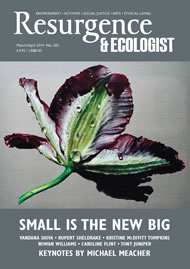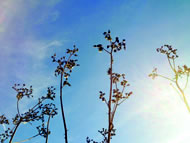It was Karen who noticed it first. The spider’s web. Pinned high up between two reeds, its dew-laden, leggy sinews were thick with the mid-morning light. There was only a week until the dawn of November but the air was bearing no ill will, and with so little threat from the weather, the taut tapestry hung at ease in calm suspension. We eyed the netted illumination as we trod the path down deep into the vegetation – a guide star for our pilgrimage to the site of the resurrection.
I had travelled out to Crayford, just west of the River Darent, to pay homage to a plant on the verge of rebirth. For over a year I’d been aware that the native Sonchus palustris, the Marsh sow-thistle – a plant now extinct in London – was being nurtured back to life. Its seed had been rescued from the site of the last naturally occurring population, and botanists and volunteers had been growing young plants on their balconies and in their back gardens for several years since. Given its close proximity to where it last stood, Thames Road Wetland had been identified as one of the sites that offered it the best chance of long-term survival in the wild, and news had spread that the plants were making the most of their opportunity there.
I’d been urged to visit soon if I wanted to see them in flower, or at least the remaining buttery yellow petals that had been holding out through what had been a mild autumn so far. Karen Sutton, site manager at nearby Thames Water site, Crossness Nature Reserve, had joined me on the expedition. A custodian of 54 Marsh sow-thistles that had made it through the summer with mixed results, she was eager to see what it was about the Thames Road habitat that was putting these plants at greater ease.
For a landscape that is man-made, the wetland seemed a fitting place to trial a choreographed revival of the plant. Shaped like the hull of a boat, Thames Road Wetland is a mosaic. Ditches, a small lake, reedmace and reed beds and damp causeways with willow-dominated wet woodland at its outskirts, comprise this old field turned floodplain in part-mitigation of a road-widening and housing development that lies a stone’s throw to the west of the site.
The reserve is knocked into shape by the familiar features of an urban-scape; the Dartford to Slade Green railway line, the North West Kent Sewer pipes, the thundering Thames Road, the pylons. But it breathes with wilder characters too. Its neighbours are the nearby River Cray to the west and intersecting it at the east, is the River Wansunt. Its inhabitants are many; rare, amphibious, aquatic, secretive and bold. Plants, animals and insects – communities of creatures living in a reed-flushed, tan-coloured terrain. Chris Rose is also an honorary inhabitant of sorts. A national election agent for the Green Party but volunteer site manager for waterways charity Thames 21 in his spare time, he has been using his expertise as a zoologist and self-taught botanist to meticulously record the wetland’s species activity for the last four years.
As an intimate friend of the landscape, Chris – with binoculars swinging from one shoulder –flowed through the vegetation like water, alerting Karen and myself to small piles of water vole droppings here, a clump of water mint there, as we followed with a cautious tread behind. “Hear that squealing … that’s a water rail,” he said, finger in mid-air, as if plugging himself into the screech-pitch note – a sound that had been imperceptible to me within the thick walls of our conversation.
“Once upon a time,” explained Chris, “the river would have gone back and forth across here and as a consequence, the landscape would have alternated between one kind and the next. Now the river is boxed in.” It was this, the water’s lost freedom, which did for the Marsh sow-thistle in London; bare mud sites are now rare. As part of the project, Chris has created these habitats, ensuring
there are enough patches of land that allow the plant to wet its feet.
For a plant officially extinct in London, the Marsh sow-thistles scattered in clumps along the water’s edge, at the damp heart of the site, cut an overwhelming presence. These are not the apologetic, wispy figures I’d expected of a species so endangered. The plants towered above us; at seven to nine-feet tall we had to crane our heads back in a vain attempt to look them in the eye. And they were bronzed and statuesque, in spite of their annual descent to the earth for a winter’s rest. “I’m really jealous,” said Karen, warmly. She looked up at the plants as if eyeing a row of skyscrapers, her long blond hair tinged with a halo of light. “Karen’s piling all that fertiliser on hers down at Crossness by the sewerage works to no avail,” Chris teased. “You never know, maybe next year will be my year,” said Karen, laughing.
Chris and Karen’s gentle banter bore no genuine competitiveness; both well aware that the Marsh sow-thistle’s current survival at Thames Road was predestined to be smoother. The last naturally occurring seed of the plant was rescued from a short tidal stretch of the River Cray at Crayford Marshes, on the other side of the railway line, only hundreds of metres away. Botanist Dr Mark Spencer, senior curator of the British and Irish herbarium at the Natural History Museum, who is leading the plant’s reintroduction, chose Thames Road Wetland because of its proximity to the Crayford site, with support from the site’s owner Bexley Council. Chris, who has nurtured around 450 young plants at his home from seeds, planted out the first specimens in May 2011 when they were two-feet high. A year and a half later, they had climbed to nine foot.
I pinched some soft, white claws from a dehydrated flower head and scattered the seeds around me on the bank. For a plant that looks bold enough to take care of itself, it felt to be an empty gesture. But it was apt. The Marsh sow-thistle – which has long made a home out of London’s riversides and tidal mouths until its habitats were buried alive by development – may look strong, but its long-term survival is dependent on it being able to spread without help. And bold as they are, there is as yet no evidence of self-sown seedlings, even though 60 of the 86 Marsh sow-thistles planted at Thames Road Wetland over the last few years are currently alive.
Until the Marsh sow-thistles are propagating themselves freely, those guiding this process will walk a fine line between giving them the best chance of survival and creating an environment too unreal to be sustainable in the long term. Deptford’s Creekside Discovery Centre is also trialling Marsh sow-thistle plants as part of the project. As its resident conservationist Nick Bertrand told me a week earlier: “In the end, you cannot mollycoddle. The plants have to fend for themselves, mix in and get on with it.”
The Thames Road Wetland batches are therefore nurtured as seed sources for new wild colonies. But before the seed even gets chance to drift and burrow deep into the mud, the plants have several small yet determined challenges with which to contend. Chris took us along the bank to examine a few chewed-up stems, snapped off before the flower heads were mature enough to offer up fresh seed. Water voles, endangered species too, are key suspects. Exclusion fences in the shape of chicken wire could help protect them but, as Chris explained, “They have to survive or not.” “Then what’s the solution?” I asked. “Hope. Hope that they don’t eat them all,” said Chris.
Our journey ended under a poplar tree, where a moon of mistletoe, shy and high in the tree’s branches
was just discernible behind its gently fluttering leaves. Standing back to look at the wetland like visitors to a gallery, it was clear that the Marsh sow-thistle was just one of many species fighting to adapt in ever-smaller windows of possibility, ever-smaller wedges of space.
Wetland is, as Karen described, hard to manage; left to its own rhythm Thames Road Wetland would turn to woodland as decaying plant litter dries the water and the level of soil eventually builds back above the water table. The in-between stage of these two opposing states - wet woodland – is already emerging at the site’s outer reaches in the proliferation of willow. Chris must pull some out to maintain many miniature environments, therefore ‘fossilising’ them for refuge populations of all kinds. As Karen said of Crossness: “You are constantly trying to be all things to all wildlife; create more open-water reed bed for reed warblers; older, drier reed bed with scrub for the sedge warbler, and pulling up weeds in places but maintaining them elsewhere because they are nectar-rich.”
I put my hand on my forehead to shield my eyes from the sun and glanced out. I was scanning for the spider’s web, keen to see it one last time before heading back to the road. It seemed to have simply vanished, as if it had never really been there at all. That ethereal creation of many fragile, passing strengths – now only a figment of our memories.







